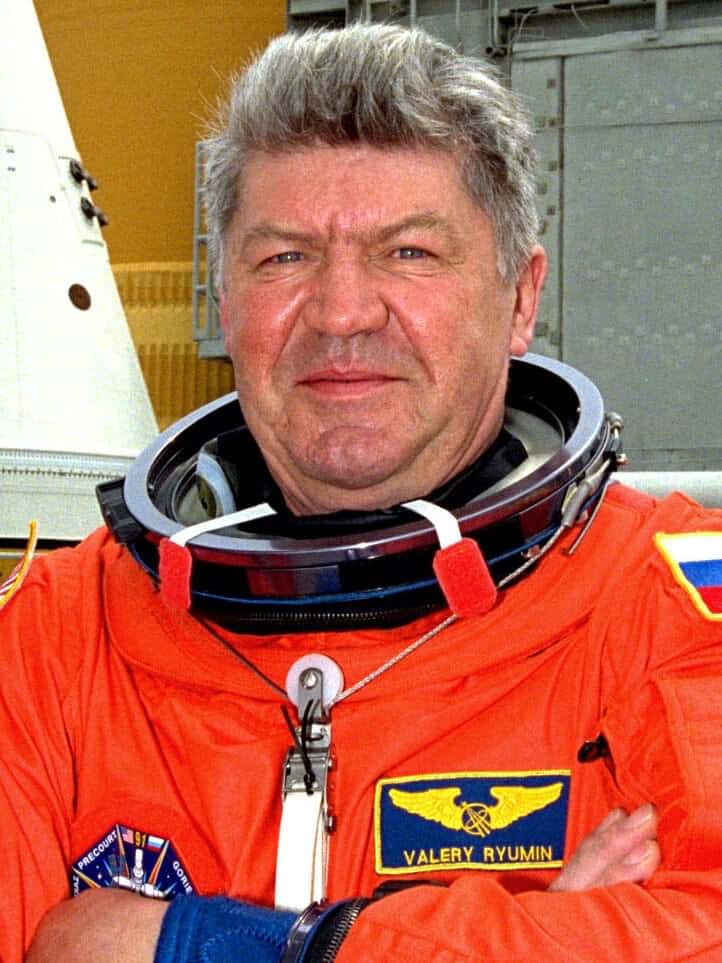Valery Viktorovich Ryumin, a two-time Hero of the Soviet Union, had the unique opportunity to witness the beauty of Earth from the window of a spacecraft not just once, but four times. Throughout his illustrious career, he had the privilege of being a part of both Soviet and international space crews. Revered by his fellow astronauts, Valery Viktorovich played a pivotal role in the successful realization of the Russian-American joint project “Mir – Shuttle”, where he served as a specialist aboard the American spacecraft “Discovery”.
Childhood and adolescence
Valery Ryumin, the cosmonaut and twice Hero of the USSR, was born in the Far East, in Khabarovsk Krai. He spent his early childhood in Komsomolsk-on-Amur. Valery Ryumin is of Russian nationality. The parents of the future pilot-cosmonaut were involved in aviation and space: Victor and Alexandra Ryumin worked at the aircraft plant, which is now named after Yuri Gagarin.
The desire to go beyond the earth had been dormant in Valery since childhood, but it only awakened and became clear at the age of 27. Prior to that, in 1954, the future cosmonaut graduated from an eight-year school in Zagoryanka, a village near Moscow, where his parents had moved before the war.
Before joining the military, the young man who would later become a cosmonaut spent three summer months working as an apprentice turner at the production base of OKB-1 in Korolev. Following his time in the army from 1958 to 1960, he pursued higher education at a forestry engineering university in the capital where he chose to study electronics. In 1966, he graduated with a diploma from the university, earning the title of electrical engineer.
Cosmonautics
The Central Space Bureau in Korolev welcomed the young engineer, who had already established a connection with them prior to his military service. However, this time Ryumin returned to OKB-1 not as an apprentice, but as a full-fledged engineer. Over the course of 3 years, he quickly advanced to the role of a senior engineer within the bureau. And thus, Valery Viktorovich’s journey into the realm of space exploration began.
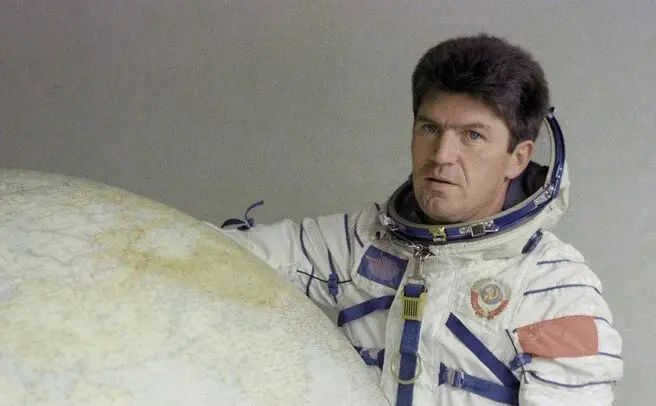
The engineer designed mechanisms for electrically testing aircraft intended for a journey to the Moon. In the early 1970s, Valery Ryumin was appointed as the deputy chief designer of the Salyut orbital stations and as a flight manager. In 1973, the 34-year-old designer joined the group of cosmonauts. Ryumin and his colleagues underwent training for flights on Soyuz spacecraft and orbital stations of the same series.
Valery Viktorovich made his first journey into space on October 9, 1977, alongside his partner Vladimir Kovalyonok. The astronauts remained in orbit for 3 days – this short duration was due to the malfunction of the Soyuz-25 spacecraft, which failed to dock with the station because of technical issues. The cancellation of the docking led to the termination of the mission.
In February 1979, when he reached the age of 40, the pilot made his second journey into outer space. Vladimir Lyakhov was chosen as the commander of the Soyuz-32 spacecraft. The duration of the flight was 175 days. In the middle of August, the crew members performed an unplanned spacewalk to fix a problem with a tangled radio telescope antenna.
Upon their return to Earth on August 19, the pilots of Soyuz-32 were honored with the title of Heroes of the USSR. Ryumin and Lyakhov received the Order of Lenin and Gold Star medals in recognition of their bravery and heroism.
A year later, Valery Ryumin went into orbit for the third time and spent 185 days on board. The crew of Soyuz-35 and the Salyut-6 research complex, led by Leonid Popov, completed 4 missions, including 3 international ones. Another “Gold Star” medal was added to Valery Viktorovich’s collection of awards.
Job Titles
Following three trips to outer space, Ryumin was assigned the role of deputy director and later promoted to head of the field testing division. Subsequently, Valery Ryumin held positions at TsUP – Central Mission Control, initially as an interim manager and eventually as the director of testing.
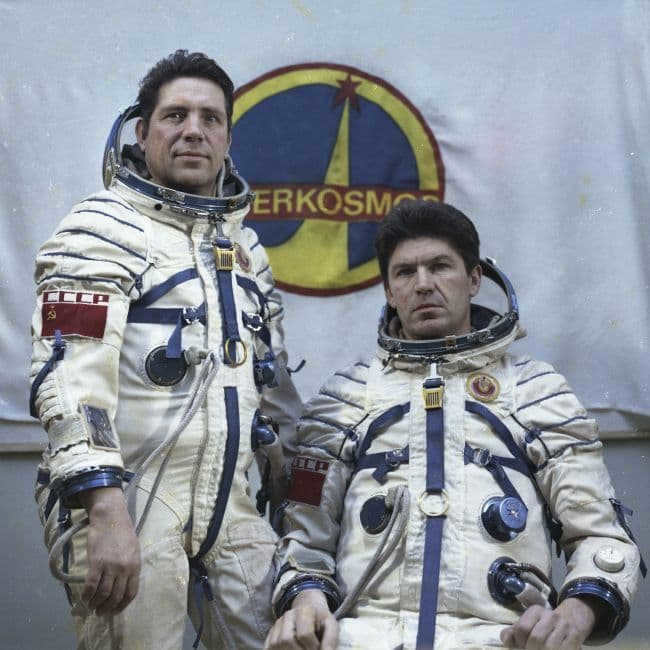
In 1982, Ryumin began a 7-year tenure overseeing the development of ships and stations at the Energia Research and Production Association in Korolev. Valery Viktorovich and his team were responsible for creating the Salyut and Mir orbital stations, as well as the reusable Buran spacecraft. The NPO also played a crucial role in launching the Progress series of space cargo carriers.
In 1987, Valery Ryumin decided to retire from his position as a cosmonaut and shift his focus towards further developing ships and stations.
Record-breaking space journey
In 1994, Ryumin, hailing from Russia, was assigned to lead both the “Mir” – NASA and “Mir” – “Shuttle” programs. He held this position for a duration of 4 years. Then, in 1997, Valery Viktorovich, a 58-year-old cosmonaut, successfully passed a medical examination and became a part of the crew for the American shuttle “Discovery”. The pre-flight preparations took place in the United States at the Lyndon Johnson Space Center. The crew of the spacecraft had room for two female pilots.
According to an interview with Ryumin’s friend and colleague, Alexander Alexandrov, the American side initially had reservations about the Russian cosmonaut’s candidacy due to his age, weight, and height. However, Valery Viktorovich managed to prepare himself for the journey. During the weight assessment, he showed a weight of 99.5 kg, just below the critical threshold of 100 kg.
The fourth flight, which began on June 2, 1998, lasted for a total of 10 days. During this mission, the American shuttle successfully docked with the Russian Mir station. Valery Ryumin, a Russian cosmonaut, spent a total of 371 days in orbit, making him the longest-serving cosmonaut at that time. This flight also made Valery Viktorovich the oldest Russian cosmonaut to ever make a space journey, surpassing the previous record set by Gennady Strekalov. Since 2013, Pavel Vinogradov has held the record.
After completing his fourth flight and retiring as a shuttle pilot, Valery Ryumin transitioned to working on the ground. He took on senior positions at the Energia Corporation in Korolev and became the head of the ISS program. This marked a new chapter in his career, where he continued to contribute to the field of space exploration.
Personal life
Valery Ryumin has been married twice. His first marriage was to Natalia, who worked at RSC Energia. The couple had two children: a daughter named Victoria, born in 1965, and a son named Vadim, born in 1972. However, their personal relationship did not work out.
In 1985, Ryumin got married for the second time. He met Elena Kondakova, who was 18 years younger than him, while he was in charge of the TsUP. At that time, Elena was a young specialist responsible for non-emergency situations.
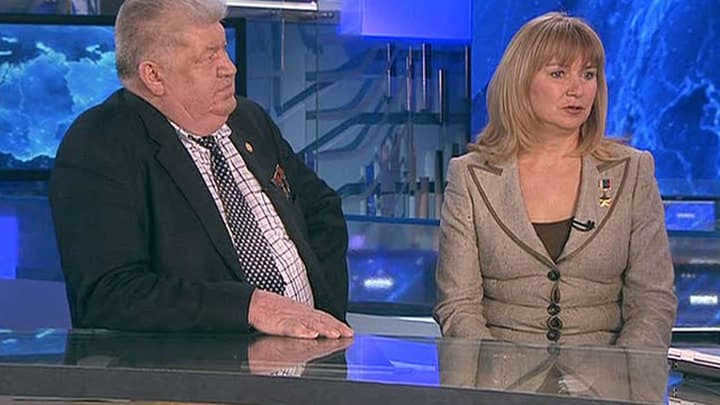
Ryumin’s unexpected proposal came after just two days of getting to know each other and caught Kondakova completely by surprise. It took her a year to finally agree to become Valery Ryumin’s wife. In the mid-1980s, their marriage was blessed with the birth of their daughter Eugenia. This family was truly unique, as both Valery and Elena were seasoned pilot-cosmonauts who had ventured into orbit multiple times.
Initially, Valery Ryumin dismissed his wife’s desire to travel to space as a passing whim. However, Elena managed to overcome his resistance. When their daughter Zhenya turned 3 years old, Kondakova successfully passed the medical commission. Five years later, she embarked on her first space flight, spending a remarkable six months in orbit.
In his leisure time, Valery Viktorovich enjoyed engaging in fishing, exploring the forest in search of mushrooms and berries. He closely followed the accomplishments of Russian soccer and hockey players, and indulged in reading historical books and memoirs of famous personalities.
Passing Away
The astronaut departed from this world on June 6, 2022, at the age of 83. The exact cause of Valery Ryumin’s demise was not disclosed. Dmitry Rogozin, the head of Roscosmos, expressed his condolences to the bereaved family, describing Ryumin’s death as an irreplaceable loss for everyone.
Awards
- 1979, 1980 – Twice recipient of the Hero of the Soviet Union title
- 1979, 1980 – Order of Lenin
- 1979 – First Class Instructor-Cosmonaut Test Pilot
- 1980 – Honored Master of Sports of the USSR
- 1999 – Order “For Merit to the Fatherland” IV degree
- 2001 – Order of Dostyk, 2nd degree
- 2011 – Medal “For Merits in Space Exploration”
- 2015 – Alexey Leonov Medal
Engaging tidbits
- During the final orientation of the station, the crew found themselves in a race against time as they almost overslept the preparation. With only 18 minutes remaining for assembly, they had to work without spacesuits. It was later discovered that the onboard clock, originally designed to last for 99 days, had actually endured for almost twice as long. As a result, they had to activate the spare clocks to ensure a smoother process.
- Even in the vastness of space, there was room for playful antics. On the third expedition, one of the pilots managed to sneak a cucumber on board the ship. To everyone’s surprise, he presented it to his colleagues back on Earth, claiming that it had miraculously grown during their time on the station.
- Leonid Popov and Valery Ryumin, the two astronauts, were honored with a postage stamp featuring their portraits.
- The cosmonaut’s associates Sergei Nikitin and Yuri Vizbor collaborated on a collection of songs titled “Ryuminiada”, which they gifted to Ryumin on his birthday in August 1980 via a teleconference.
- Valery Viktorovich authored the books “A Year Away from Earth” and co-wrote “RSC Energia named after S. P. Korolev”.
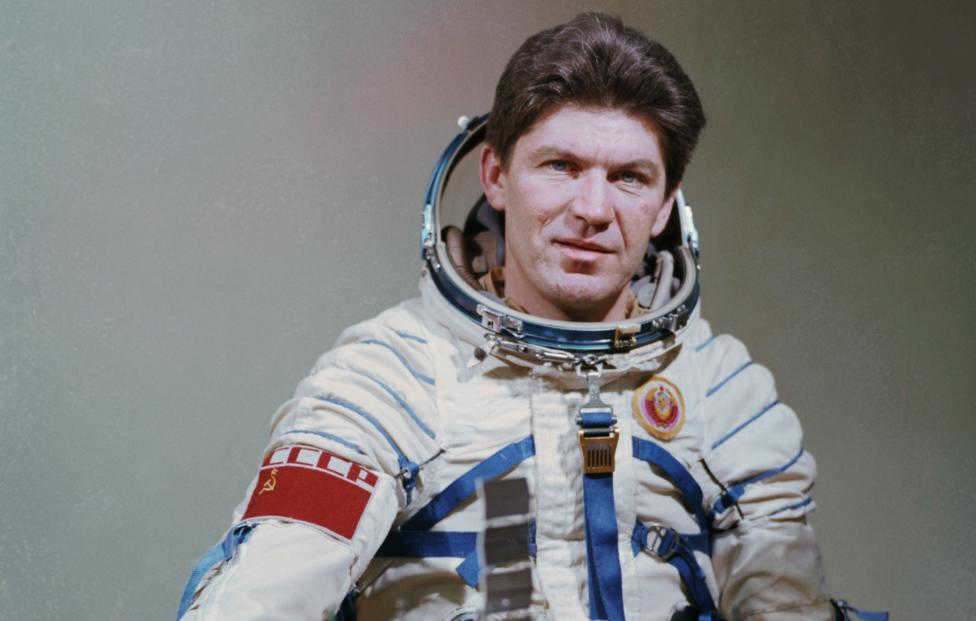
TASS-DOSIER. On June 6, Roscosmos announced the passing of Valery Ryumin, a pilot-cosmonaut of the USSR and a double Hero of the Soviet Union. He died at the age of 83.
Valery Ryumin was born on August 16, 1939 in Komsomolsk-on-Amur, located in the Khabarovsk Territory. He was raised in a family of an engineer, with his father Viktor Nikolaevich working as a shop manager and chief technologist at the aviation plant in Komsomolsk-on-Amur. Prior to the outbreak of the Great Patriotic War, the family relocated to the Moscow region.
In 1958, Valery Ryumin completed his studies at the Kaliningrad Mechanical College (formerly located in Kaliningrad, now Korolev, Moscow region) with a major in “cold metal working”. In 1966, he graduated from the Faculty of Electronics and Computing and Solving Technology at the Moscow Forestry Institute, specializing in “electrical engineering”.
In 1980, Ryumin successfully defended his thesis and obtained the degree of Candidate of Technical Sciences.
Labor and involvement in society
From July to November 1958, Valery Ryumin gained practical experience as an apprentice revolver turner at Plant No. 88 in the Moscow Region. This plant served as the production base for OKB-1 (later known as the Central Design Bureau of Experimental Mechanical Engineering, CDBEM, then NPO Energia, and currently S.P. RSC Energia) under the leadership of Korolev.
Following his time at the plant, from November 1958 to July 1961, Ryumin served in the tank forces of the USSR Armed Forces. He was stationed in military units located in the Azerbaijan SSR, which is now known as Azerbaijan.
Starting in November 1965, he began his career as a trainee technician in the 39th Department of OKB-1. He progressed to the roles of engineer (from 1966) and senior engineer (from 1969) in the 721st department. Additionally, he served as the deputy leading designer for the Salyut long-term orbital station (from 1970). He actively contributed to the development of documentation for electrical tests of the manned spacecraft “7K-L1” for lunar orbit, which was one of the modifications of the “Soyuz” spacecraft. Furthermore, he was frequently assigned as a test manager and technical supervisor for these projects.
He was a member of the cosmonaut team at NPO Energia from March 1973 to October 1987, but he was dismissed due to age. Initially, he served as a test cosmonaut starting in 1973, then became Deputy Head of Complex #11 in 1981. In January 1982, he took on the role of Head of the Complex and Flight Manager of the Salyut-7 orbital station. Simultaneously, he worked for the Space Research Institute of the USSR Academy of Sciences.
His career took a new turn in June 1986 when he was appointed Deputy General Designer of NPO Energia. From 1986 to 1994, he oversaw the flight operations of the Salyut-7 and Mir orbital stations. Then, from 1994 to 1998, he served as the head of the Mir – NASA and Mir – Shuttle programs from the Russian side.
Starting from October 1998, he served as the Deputy General Designer at RSC Energia. He also held the positions of director of the International Space Station program and head of the scientific and technical center for testing and flight control.
In 1989, he was elected as a People’s Deputy of the USSR.
Space flights
Valery Ryumin has successfully completed four space flights, accumulating a total duration of 371 days, 17 hours, 26 minutes, and has also conducted one spacewalk lasting 1 hour and 23 minutes. He was recognized as a class I test instructor-cosmonaut in 1979.
Valery Ryumin served as the flight engineer for the third main expedition to the Salyut-6 station, under the command of Vladimir Lyakhov, from February 25 to August 19, 1979. The main objective of this mission was to install a space radio telescope called KRT-10 into Earth’s orbit. The plan was to assemble the telescope in the station’s transition compartment and then release it into space. However, during the installation process, the telescope’s antenna got entangled with the structure of the Salyut-6 station. To resolve this issue, Lyakhov and Ryumin had to perform a spacewalk to manually detach the telescope from the station. The crew embarked on their journey aboard the Soyuz-32 spacecraft and safely returned to Earth on the Soyuz-34.
During the third flight, which occurred between April 9 and October 11, 1980, Valery Ryumin served as the flight engineer on board the Soyuz-35 spacecraft. This mission was part of the fourth primary expedition to the Salyut-6 space station, under the command of Leonid Popov. Throughout the duration of the mission, the station’s main crew welcomed four visiting expeditions, three of which were international and involved astronauts from Hungary, Vietnam, and Cuba. The journey back to Earth was made on the Soyuz-37 spacecraft.
At the age of 58, Valery Ryumin embarked on his fourth space flight, nearly a decade after retiring from the cosmonaut squadron. From June 2-12, 1998, he served as a flight specialist on the American shuttle Discovery, which had the objective of docking with the Russian orbital complex Mir. This mission marked Ryumin as the oldest Russian cosmonaut to have ever been in orbit. (This record was later surpassed in 2013 by Pavel Vinogradov, who was 59 years old at the time.) Ryumin also became the third oldest cosmonaut in the world.
Awards and Honorary Titles
He has been honored with the prestigious title of Hero of the Soviet Union on two occasions, in 1979 and 1980. Additionally, he has been bestowed with the esteemed Orders of Lenin three times, in 1977, 1979, and 1980. In 1999, he was awarded the Order “For Merit to the Fatherland” IV degree, and in 2011, he received the Medal “For Merit in Space Exploration”. Furthermore, he was presented with a Certificate of Honor by the President of the Russian Federation in 2009.
His contributions to the field of science and technology in defense matters were recognized with the State Prize of the USSR in 1984 and the State Prize of the Russian Federation in 1999.
He also received numerous foreign awards and titles, including the title of Hero of the Hungarian People’s Republic in 1980, Hero of Labor of the Socialist Republic of Vietnam in 1980, Hero of the Republic of Cuba in 1980, as well as the Order of Ho Chi Minh from Vietnam and the Order of Playa Giron from Cuba, among others.
Furthermore, he holds the distinguished titles of Pilot-Cosmonaut of the USSR since 1977 and Honored Master of Sports of the USSR since 1980.
He became a member of the International Academy of Astronautics in 1996, and he was also granted honorary citizenship in Baikonur, Kazakhstan in 1979, as well as in Kaluga in 1980, Komsomolsk-on-Amur in 1981, and various other cities.
Furthermore, he authored several publications in both Russian and foreign scientific journals, including the book “A Year Beyond Earth” in 1987. Additionally, he served as a co-author for the book “RSC Energia, named after S.P. Korolev” in 1996.
Personal details
Valery Ryumin entered into a second marriage. His wife, Elena Vladimirovna Kondakova (born 1957), is a cosmonaut and a former member of the Russian State Duma (1999-2011).
A bronze bust of Valery Ryumin has been erected in Komsomolsk-on-Amur.
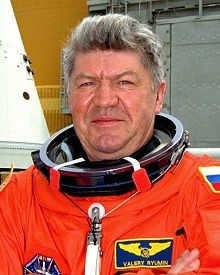
Valery Viktorovich Ryumin (b. 1939) is a Russian cosmonaut, Hero of the USSR and a man who has ventured beyond the confines of Earth on four separate occasions. Cosmonaut Ryumin boasts an impressive biography, filled with numerous accolades and accomplishments. He has worked alongside both domestic and international teams, making substantial contributions to the advancement of space exploration.
Early years
Valery Viktorovich was born into a typical Soviet family. He spent his formative years in his hometown in Khabarovsk Krai, and later relocated to a village near Moscow. The cosmonaut’s parents had a deep connection to his future profession, as his father and mother both worked at the Yuri Gagarin plant.
As a child, Valera would eagerly listen to his parents’ stories about their work. He had dreams of venturing into space, although he did not have a strong desire to attend a university specifically for cosmonautics. During the wartime years, the Ryumin family moved from the Far East to the Moscow region, eventually settling in Zagoryanka, where Valera completed his eight grades of schooling.
After obtaining his certificate, Valery Viktorovich enrolled in a mechanical technical school in the city of Kaliningrad. He decided to pursue a specialization in “metallurgy.” The diligent student regularly attended lectures and focused on studying the techniques of cold metalworking. Following successful exams and the receipt of his diploma, Ryumin joined the army. He devoted himself to serving his homeland in the tank corps. He was deployed to Azerbaijan for a duration of 2 years.
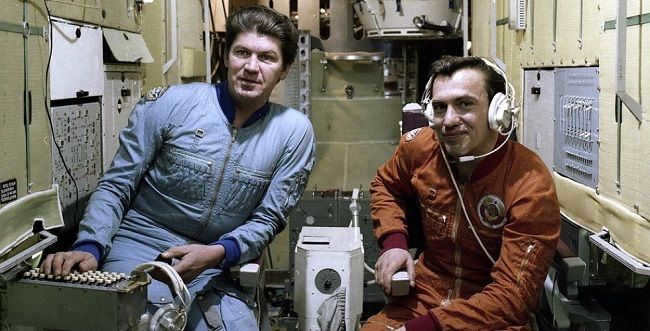
During his early days, Ryumin was employed at the manufacturing facility of OKB-1, situated in the town of Korolev.
Upon completing his military service, Valery Ryumin enrolled in the Forestry Institute in Moscow. He pursued a degree in electronics and graduated as an engineer in 1996.
After completing his studies, the engineer secured a job at the Central Space Bureau, which is situated in the city of Korolev. He had previously been employed by the organization for a period of three months, so he was already familiar with the team. However, this time he was hired as a qualified engineer rather than an assistant. It didn’t take long for him to climb the ranks and become a senior engineer.
During his early days at the bureau, Ryumin was primarily involved in developing mechanisms for testing spacecrafts designed for lunar missions. In the early 1970s, he transitioned into the role of chief designer at the Salyut space stations. He was responsible for managing the flights, and in 1973, he became a part of the cosmonaut team.
In early October 1977, the engineer experienced his first journey into outer space alongside his partner, Vladimir Kovalenok. They spent three days in orbit before encountering a setback that forced them to halt their flight. The malfunctioning aircraft hindered their ability to successfully complete the docking process.
Two years later, in 1979, the cosmonaut embarked on his second space mission. This time, the flight lasted an impressive 175 days. In the middle of August that year, they once again ventured into outer space to remove an antenna.
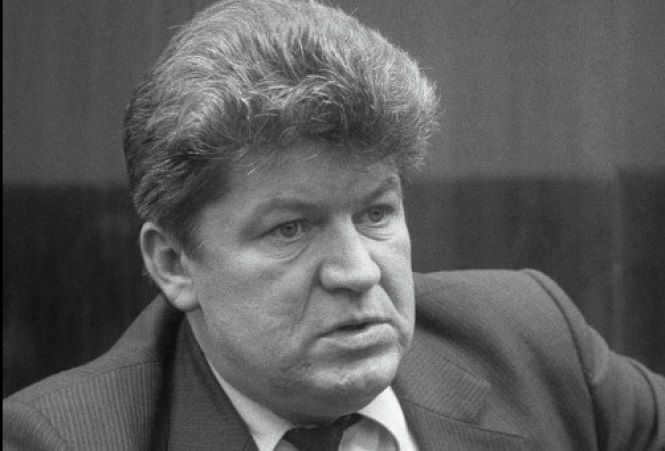
In August 1979, the astronaut was honored with the title of Hero of the USSR. He was also presented with the Gold Star Medal and the Order of Lenin for his bravery and heroism.
In 1980, Valery embarked on his third space mission, during which he spent 185 days in orbit. Subsequently, he assumed the role of chief of the complex and worked in the Central Flight Directorate.
In 1982, the pilot-astronaut was appointed as the head of the Energia Association. For a period of 7 years, he held a prominent position and actively contributed to the development of spacecraft.
In 1987, Valery Ryumin retired from the ranks of cosmonauts but continued to be involved in development. In 1994, he took on the role of leading international space programs. After working in a leadership position for 4 years, Ryumin joined the crew of the American Discovery team. Together with his American counterparts, he underwent extensive preparation for the upcoming flight.
Interestingly enough, the American colleagues initially had reservations about accepting a Russian pilot on board the ship. They had concerns not only about the pilot’s age but also his physical condition.
The cosmonaut’s fourth flight commenced on June 2, 1998. Following a successful docking, Ryumin spent a total of 371 days in space.
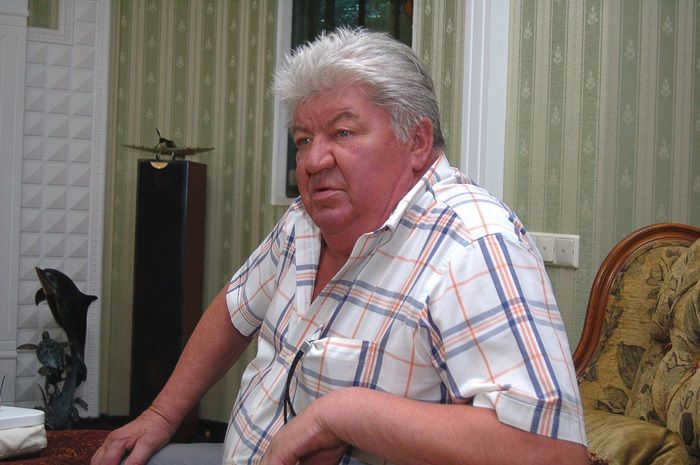
Valery Viktorovich made history in 1998 when he became the oldest cosmonaut in Russia.
After retiring from his career as a pilot in 1998, Ryumin joined Energia in a managerial role and remained there until the end of his life.
Cosmonaut Ryumin is also known as the author of the book “A Year Off Earth”.
Personal life
Journalists have always been interested in the personal life of the astronaut. He has been married twice and has children.
The pilot’s first wife was a woman named Natalia, who worked at Energia. In 1965, Natalia gave birth to their daughter Victoria. Seven years later, they had a son named Vadim. However, the birth of their children did not strengthen their relationship, and the couple eventually filed for divorce. Despite their separation, they continued to work together to raise their children. Valery’s children did not follow in his footsteps and chose more “grounded” professions for themselves.
In 1985, Valery Viktorovich got married for the second time. His new wife was Elena Kundakova, a junior specialist at the Mission Control Center.
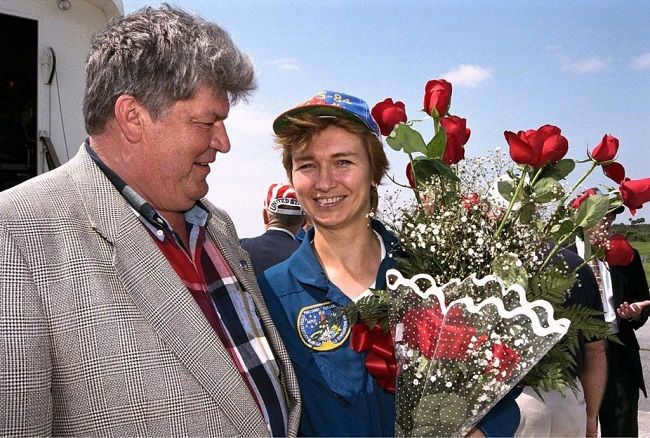
Valery Ryumin, the cosmonaut, was 18 years older than his second wife.
After their first meeting, Ryumin was so captivated by the girl that he immediately proposed to her. However, it took a year for her to give her consent. In 1986, Elena and Valery welcomed their first child, a daughter named Eugenia.
Demise
On June 6, 2022, news emerged regarding the passing of the revered astronaut. The specific cause of demise was not disclosed to the general public. The departure of Valery Viktorovich was a significant blow to the national space program. He played a pivotal role in advancing the country’s space industry and was honored with numerous accolades, decorations, and prestigious titles.
- Ryumin’s second wife went into space twice, so the pilot-cosmonaut’s family was rightfully considered “space”.
- In his spare time, the cosmonaut enjoyed fishing. He would often go for walks in the fresh air and gather mushrooms and berries in the forest.
- In 1980, Yuri Vizbor and Sergei Nikitin presented musical compositions dedicated to their friend – cosmonaut Ryumin.
The Earth globe was seen four times from the porthole by Valery Ryumin, the 41st pilot-cosmonaut of the USSR. The Soviet Union hero was in orbit twice as a flight engineer, three times on domestic “Soyuz” series ships, and once as a flight specialist on the American “Discovery”.
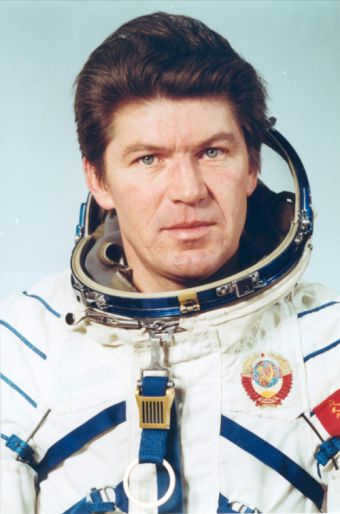
The space career of Valery Viktorovich Ryumin reached its climax with his final mission at the age of 58. The Ryumin family has rightfully earned the title of a space family, as Valery’s wife, Elena Kondakova, has also ventured into extraterrestrial orbit twice.
The Path to Space
The life story of the future hero began in 1939. The boy was born in Komsomolsk-on-Amur in the Far East on August 16. Both of his parents were involved in the aviation industry, working at an aircraft factory. From a young age, Valery had a dream of flying, but it wasn’t until he turned 27 that he started to pursue it.
Prior to the war, his family relocated to Zagoryanka near Moscow, where Ryumin completed his schooling in 1954. After graduating, he furthered his education at the Mechanical College in Kaliningrad, specializing in cold metalworking. As part of his training, Valery worked as a trainee turner at OKB-1 for three months during the summer.
In 1958, he enlisted in the army, serving until 1960. Following his military service, he enrolled in a university in the capital city and graduated in 1966.
The young expert was assigned to work at the Central Space Bureau in Korolev, a place he was already familiar with. However, Valery came back not as an intern but as a professional. After three years, he was promoted to the position of a senior engineer. His main tasks involved designing mechanisms for spacecraft intended for lunar flights.
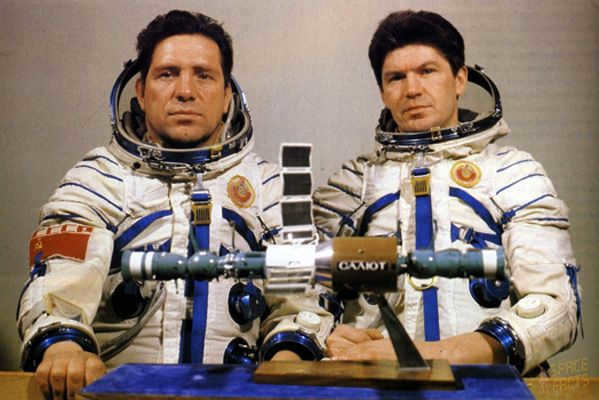
During the early 1970s, Ryumin took on the role of leading flight management and became the deputy chief designer for the orbital stations “Salyut.” He joined the squadron of cosmonaut applicants in 1973 and trained pilots for missions on the “Soyuz” series.
In 1977, Valery Viktorovich went into orbit for the first time. On October 9, he spent 3 days in space. The duration of the stay was determined by a malfunction that prevented the Soyuz-25 from docking with the station. Due to the changing circumstances, the flight had to be terminated.
In February 1979, the forty-year-old pilot embarked on a new 175-day flight. The spacecraft was commanded by Vladimir Lyakhov. In mid-August, an unscheduled spacewalk took place, during which the partners were fixing a snagged antenna. On August 19, the pilots of Soyuz-32 were awarded the title of Heroes of the Soviet Union. Ryumin was honored with the Gold Star medal and the Order of Lenin.
After a year had passed, the pilot embarked on a fresh flight. He spent 185 days in orbit as a member of the crew on the “Soyuz-35”. Throughout this time, he participated in four expeditions alongside the “Salyut-6” complex, three of which were international. Upon his return, Ryumin was eagerly anticipating a new prestigious award.
Having been to space three times, the pilot assumed the role of deputy and later became the head of the test complex. Additionally, Ryumin held positions as deputy and head of tests in the Central Flight Directorate.
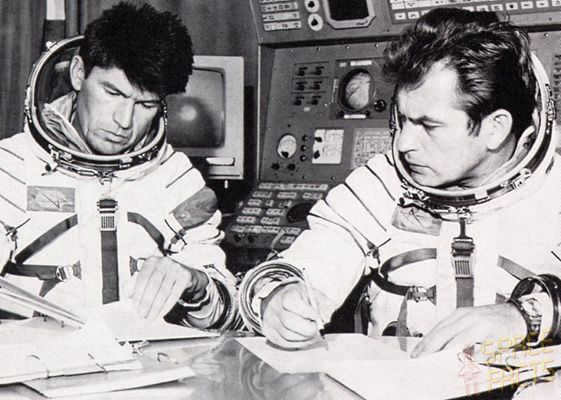
In August 1980, Ryumin was given a series of songs called “Ryuminiada” as a gift from Yuri Vizbor and Sergei Nikitin.
New Duties
From 1982 to 1989, Valery Viktorovich was involved in leading the development of ships and stations at the Royal NPO Energia near Moscow. The team specialized in the Mir and Salyut orbital stations, the Buran reusable manned spacecraft, and the Progress cargo carriers for space.
In the autumn of 1987, Ryumin left the cosmonaut team and focused all his efforts on development. In 1994, he took on the position of head of the Mir-Shuttle and Mir-NASA programs as a representative of Russia. He held this important position for four years.
In 1997, just before turning sixty, Ryumin joined the crew of Discovery. The preparation for the flight was conducted at the U.S. Space Center. The flight took place on June 2, 1998 and lasted for a decade. The American shuttle successfully docked with the domestic station.
During his career, the cosmonaut spent more than a year, 371 days, in orbit. Ryumin had two marriages. His first partner was an employee of RSC Energia. In 1965, he and Natalia welcomed their first child, a daughter named Victoria. Their son Vadim was born in 1972.
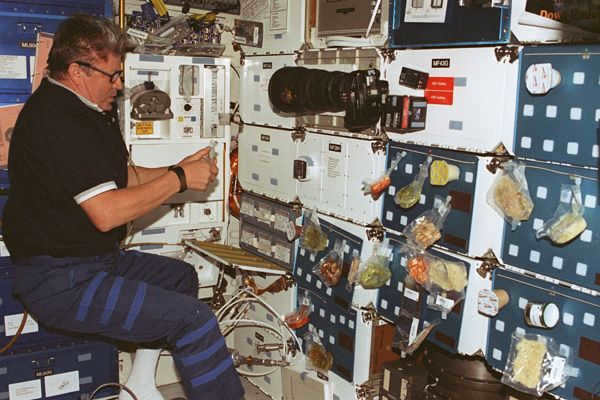
Elena Kondakova became the second wife of cosmonaut Valery Viktorovich in 1985. They met when Ryumin was in charge of the TsUP, and Kondakova was a young specialist responsible for emergency situations. It only took a few days for the cosmonaut to realize his feelings for her, which came as a surprise to Kondakova. It took Ryumin a year to win her consent. Together, they raised a daughter named Eugenia, who was born in the mid-eighties.
The husband strongly objected to his wife’s ambition to venture into space. However, Elena managed to assert her own desires and successfully went into orbit twice, earning the prestigious title of Hero of the Soviet Union.
During her first space mission, their daughter was just 3 years old. Five years later, Elena embarked on another space journey, which lasted for 6 months. The husband anxiously awaited her return, greeting her at the landing site with a grand bouquet of roses.
Their children did not follow in their father’s footsteps and pursue a career in the space industry. Instead, they have chosen different paths and are engaged in occupations unrelated to space.
Valery Viktorovich, the father, enjoys spending his free time fishing and foraging for forest treasures. He also takes pleasure in taking leisurely walks in the woods and is a loyal supporter of Russian sports teams.
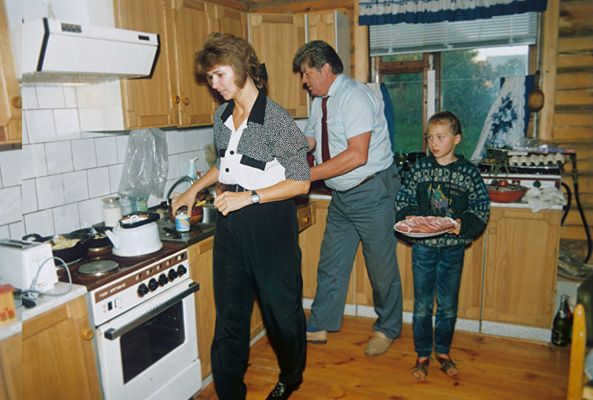
The astronaut has a penchant for reading memoirs of famous people and has a deep interest in history. Valery Viktorovich has authored the books “A Year Away from Earth” and “RSC Energia named after S. P. Korolev”, where he participated as a co-author.
- Valery Ryumin – biography, photos, personal life of the astronaut, news 2018
- Valery Ryumin
- Pavel Ivanovich Belyaev, astronaut: biography and personal life
- Zolotukhin Valery Sergeevich: biography, career, personal life
- Voynarovskaya Elena Pavlovna: biography, career, personal life
- Biography and personal life of Valery Leontiev
- Biography, career, and personal life of Lyudmila Ryumina
- Valery Komissarov’s wife: photo
- Biography, career, and personal life of Valery Stepanovich Storozhik
- Biography, career, and personal life of Syutkin Valery Miladovich
- Biography, creative work, career, and personal life of Valery Klimov
- Biography, career, and personal life of Kovtun Yuri Mikhailovich
- Why did Putin fly with cranes?
- Biography, creative work, career, and personal life of Valery Malakhov
- Biography, creative work, career, and personal life of Yuri Sorokin
- Biography, creative work, career, and personal life of Valery Shuvalov
- Yuri Vizbor: a look into his life
- The life and career of Lyudmila Porgina
- Marina Kovtun: a glimpse into her biography and achievements
- Valery Vorona: exploring his life, work, and personal journey
- Valentina Sergeyeva: a closer look at her life, career, and personal endeavors
- Valery Zubarev: a comprehensive biography of his life, work, and personal experiences
- Valery Belyakov: delving into his biography, creative work, career, and personal life
- Lyudmila Putina: uncovering her life, creative work, career, and personal journey
The Orthodox Church designates specific periods of time for individuals to reflect on their lives and spirituality. These designated periods within the Church hold great importance.
Valery Viktorovich Ryumin, a two-time Hero of the Soviet Union, had the fortunate opportunity to witness the beauty of our planet from the window of a spaceship not just once, but four times. As a skilled pilot-cosmonaut, he served as a flight engineer on three occasions aboard Soviet spacecraft of the renowned “Soyuz” series. Additionally, he had the honor of joining the crew of the American shuttle “Discovery” as a flight specialist for one extraordinary mission.
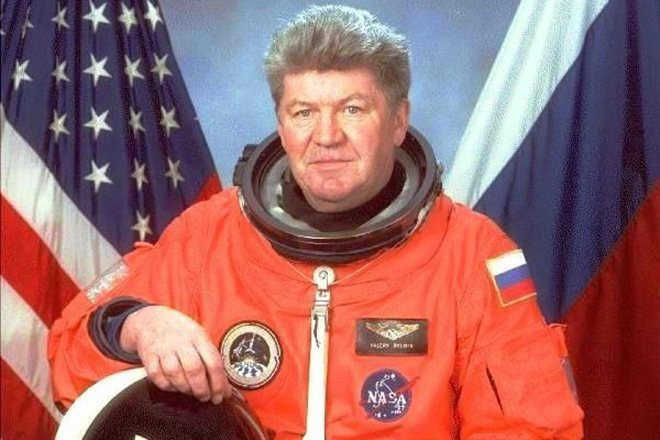
Cosmonaut Valery Ryumin
The 41st Soviet cosmonaut ended his final journey into outer space at the age of 58, surpassing the record set by his colleague Georgy Grechko. Ryumin’s achievement remained unmatched until 2013, when 59-year-old Pavel Vinogradov embarked on his own space voyage.
Ryumin’s family can proudly be called a “space family” as it boasts two pilot-cosmonauts: Ryumin himself and his wife Elena Kondakova, who has also orbited the Earth twice.
Biography of Valery Ryumin
Valery Viktorovich Ryumin, a two-time hero of the Soviet Union, had the remarkable opportunity to witness the beauty of our planet from the window of a spacecraft not once, but four times. As a flight engineer, he embarked on three missions aboard the Soviet Soyuz series spacecraft and once aboard the American shuttle Discovery, serving as a flight specialist.
As the USSR’s 41st cosmonaut, Ryumin made his final journey into the extraterrestrial orbit at the age of 58, surpassing the record set by his colleague Georgy Grechko. Ryumin’s extraordinary achievement remained unchallenged until 2013, when Pavel Vinogradov, at the age of 59, ventured into space.
The Ryumin family can rightfully claim the title of a “spacefaring family,” as it proudly boasts not one, but two cosmonauts. Valery’s wife, Elena Kondakova, has also traversed the celestial expanse on two separate occasions.
Childhood and adolescence
Valery Ryumin, the cosmonaut and twice hero of the USSR, was born in the Far East, specifically in Khabarovsk Krai. He spent his early childhood in Komsomolsk-on-Amur. Valery Ryumin is of Russian nationality. The parents of the future pilot-astronaut are involved in aviation and space: Viktor and Alexandra Ryumin worked at the aviation factory, which currently bears the name of Yuri Gagarin.
The desire to reach the heights above the earth was dormant in Valery since he was a child, but only became clear at the age of 27. Before that, in 1954, the future cosmonaut graduated from an eight-year school in the village of Zagoryanka near Moscow, where his parents moved before the war.
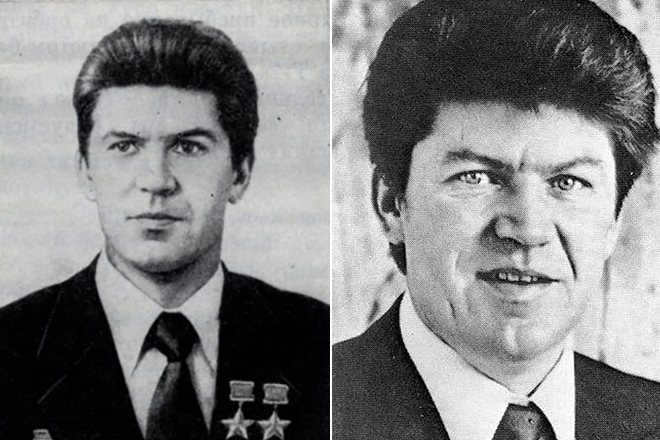
Valery Ryumin
Following his high school education, Valery Ryumin enrolled in a mechanical technical school in Kaliningrad. He specialized in cold metal processing and then went on to complete his mandatory military service.
Prior to joining the army, the future cosmonaut spent three summer months as an intern turner at the production base of OKB-1 in Korolev. After that, he served in the tank forces in Azerbaijan from 1958 to 1960. Upon his demobilization, Valery Ryumin pursued higher education at the Moscow Forestry Technical University, where he chose to study in the Electronics Department. In 1966, he successfully obtained a university diploma and the title of electrical engineer.
Cosmonautics
The Central Space Bureau in Korolev was where the young engineer found himself after his army service, a place he had encountered previously. However, this time Ryumin returned to OKB-1 not as a novice, but as a fully-fledged engineer. Within a span of 3 years, he quickly ascended to the position of senior engineer within the bureau. And thus, the “space” chapter of Valery Ryumin’s life story began.
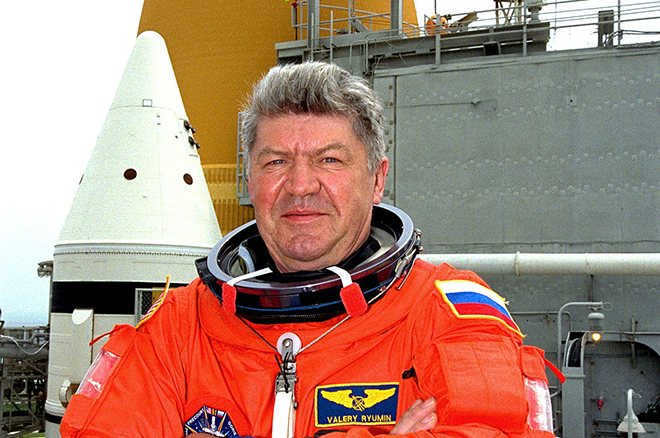
Cosmonaut Valery Ryumin
Valery Ryumin, a talented engineer, was responsible for the development of mechanisms used for the electrical testing of aircraft designed for lunar missions. In the early 1970s, Ryumin was promoted to the position of deputy chief designer for the Salyut orbital stations and also served as a flight director. At the age of 34, in 1973, he joined the group of cosmonauts and underwent extensive training for missions on the Soyuz spacecraft and orbital stations of the same series.
Valery Viktorovich made his initial journey to space on October 9, 1977, accompanied by his colleague Vladimir Kovalenok. The astronauts experienced a 3-day delay in orbit, which was a result of an issue with the Soyuz-25 spacecraft. This malfunction prevented the spacecraft from successfully docking with the space station, leading to the cancellation of the mission.
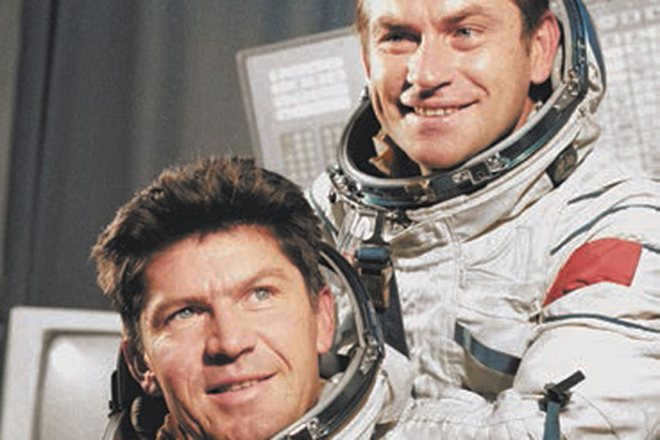
Valery Ryumin and Vladimir Kovalenok
In February 1979, Valery Ryumin embarked on his second extraterrestrial orbit, coinciding with his 40th birthday. Vladimir Lyakhov was chosen as the commander of the Soyuz-32 spacecraft. The duration of the mission was 175 days. In mid-August, the two astronauts had an unscheduled spacewalk to fix a malfunction – a snagged radio telescope antenna.
Upon their return to Earth on August 19, Ryumin and Lyakhov were honored with the prestigious title of Heroes of the USSR. They were also decorated with the Order of Lenin and the Gold Star medal in recognition of their exceptional bravery and heroism.
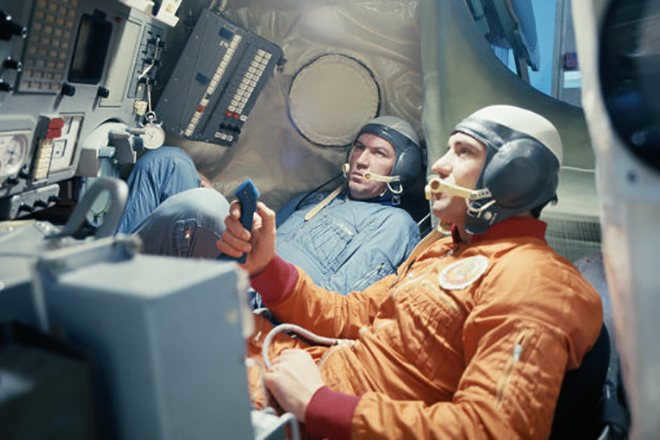
Valery Ryumin and Leonid Popov
One year later, Valery Ryumin embarked on his third journey into space, where he remained on board for a total of 185 days. During the mission, the crew of Soyuz-35 and the Salyut-6 research complex conducted four expeditions, three of which were international in nature. As a result of his achievements, Valery Viktorovich was awarded another medal – the second “Gold Star”.
Following his three space flights, Ryumin was appointed as the deputy and later became the head of the complex for field tests. Subsequently, he joined the Central Mission Directorate (TsUP) where he initially served as a substitute for the head before eventually leading the tests.
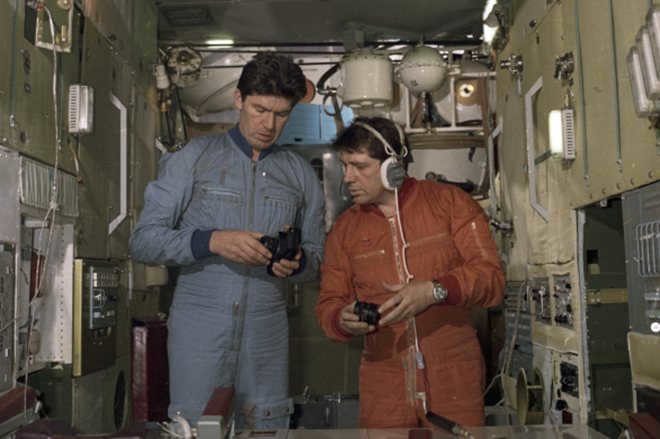
Valery Ryumin and Vladimir Kovalenok were a dynamic duo in the world of space exploration. From 1982 to 1989, Ryumin led the team at the Energia Research and Production Association in Korolev, overseeing the development of various ships and stations. This included the iconic Salyut and Mir orbital stations, as well as the groundbreaking reusable Buran spacecraft. Ryumin’s leadership and expertise were instrumental in bringing these ambitious projects to life.
During his time at Energia, Ryumin and his team also played a crucial role in the deployment of the Progress series, a fleet of space “cargo carriers” that were responsible for delivering essential supplies to the stations and spacecraft in orbit.
After seven years of dedicated service, Ryumin retired in 1987, shifting his focus towards the continued development of ships and stations. His contributions to the field of space exploration have left an indelible mark on the industry, and his legacy continues to inspire future generations of astronauts and engineers.
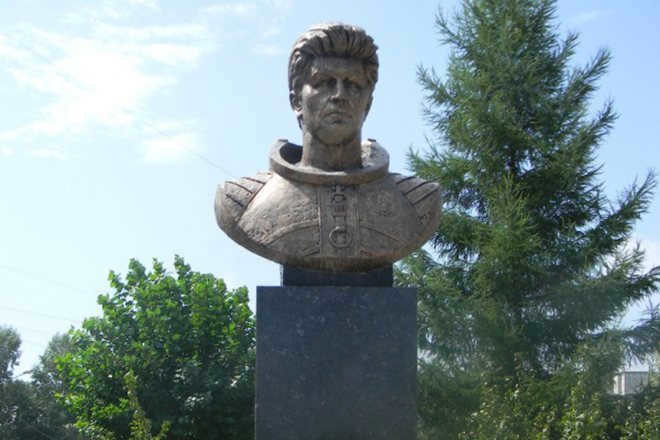
Monument to Valery Ryumin in Komsomolsk-on-Amur
Valery Ryumin was chosen from Russia to lead the Mir-NASA and Mir-Shuttle programs in 1994. He held this position for 4 years. In 1997, at the age of 58, Valery Viktorovich, after passing a medical examination, joined the crew of the American shuttle “Discovery”. The preparation for the flight took place at the Johnson Space Center in the United States, where the crew of the ship also included two female pilots.
The 10-day fourth flight began on June 2, 1998. During the mission, the American shuttle successfully docked with the Russian space station “Mir”. Valery Ryumin spent a total of 371 days in orbit.
Memorial. Valery Ryumin
Valery Ryumin, the famous astronaut, was born on August 16, 1939.
Personal information
Valery Ryumin (78 years old) Valery Ryumin was born in Komsomolsk-on-Amur, Khabarovsk Territory. His parents worked at the local aircraft factory, which now bears the name of Yuri Gagarin. Just before the war, the family relocated to the Moscow region.
In 1954, Ryumin completed his studies at the eight-year school in the village of Zagoryanka, Shchelkovsky district, and then enrolled in the mechanical college in Korolev. From 1958 to 1961, he served in the tank forces in Azerbaijan as a tank commander during his conscription.
In 1961, he joined the Moscow Forestry Institute’s faculty of electronics and computing and problem-solving technology. After graduating in 1966, he was appointed as an engineer at the Central Design Bureau of Experimental Mechanical Engineering, now known as RSC Energia. In 1969, he was promoted to senior engineer and was involved in developing materials for electrical tests on the “7K-L1” manned spacecraft designed for lunar orbit. From early 1970 until he joined the cosmonaut squadron, he served as the Deputy Lead Designer for the Salyut long-term orbital stations.
In 1973, he was accepted into the cosmonaut squadron and underwent training for space missions on Soyuz spacecraft and orbital stations of the same name.
During the period of February to August in 1979, Ryumin embarked on his second space mission alongside ship commander Vladimir Lyakhov. This mission lasted for a total of 175 days and was conducted on the Soyuz-32 spacecraft and the Salyut-6 Soyuz orbital complex. An unexpected event occurred on August 15, 1979, when Ryumin and Lyakhov had to perform a spacewalk in order to separate the antenna of the KRT-10 radio telescope, which had become entangled with the station. As a result of their bravery and heroism demonstrated during the mission, the cosmonauts were awarded the prestigious title of Heroes of the Soviet Union, along with the Order of Lenin and the Gold Star medal, on August 19, 1979.
In April-October 1980, Ryumin embarked on his third journey aboard the Soyuz-35 spacecraft and the Salyut-6 orbital research complex Soyuz. This mission set a new record for the longest duration in space at that time, lasting a remarkable 185 days. Throughout this period, the station’s primary crew welcomed four expeditions from Earth, including three international teams. Upon safely returning to Earth on October 11, 1980, the cosmonaut was honored with the prestigious second “Gold Star” medal.
Following his successful missions, Ryumin transitioned to a new role at TsUP, where he initially served as the deputy head before eventually assuming the position of head of the complex of full-scale tests. From 1982 to 1989, he held the esteemed position of head of flights on ships and stations developed by NPO Energia. This included overseeing the operations of the Salyut and Mir orbital stations, the innovative Buran spacecraft, the reliable Soyuz manned spacecraft, and the essential Progress space freighters. In recognition of his contributions, Ryumin was appointed Deputy General Designer of NPO Energia in 1986. After a distinguished career, he officially retired from the cosmonaut squad in October 1987.
Between 1994 and 1998, he oversaw the Mir-NASA and Mir-Shuttle programs from the Russian side. In 1997, at the age of 58, the cosmonaut underwent a medical examination and was chosen to participate in the STS-91 program aboard an American shuttle. From September 1997 to June 1998, he underwent training at the Johnson Space Center in the United States as a member of the shuttle Discovery crew. The fourth 10-day flight took place from June 2-12, 1998, during which the final docking of the shuttle with the Mir orbital station occurred. On March 23, 2001, the station was intentionally sunk in the Pacific Ocean.
After his return to Earth, Valery Ryumin continued his work at RSC Energia. He was promoted to the position of Deputy General Designer in charge of developing future programs, and also took on the role of Director of the International Space Station program.
Valery Ryumin has been married twice. His first wife, Natalia, also worked at RSC Energia. They have two children together: a son named Vadim (born in 1972) and a daughter named Victoria (born in 1965).
In 1985, Valery Ryumin married fellow cosmonaut Elena Kondakova, who would later become a Hero of Russia. They have a daughter named Evgenia, who was born in 1986.
Accomplishments
The 41st Soviet and Russian cosmonaut who has flown into space on three separate occasions aboard the Soyuz spacecraft and once on the Shuttle. Two of these flights have set records for their duration, each lasting approximately six months. Remarkably, one of these missions took place when Ryumin was already 58 years old. He holds the distinction of being a twice-decorated Hero of the Soviet Union. In addition to his impressive space career, Ryumin has served as one of the leaders at RSC Energia, where he is responsible for overseeing advanced programs.
Key Facts
Kondakova, who holds a degree from the diplomatic academy, was appointed as Russia’s trade representative in Switzerland in March 2012.
Straight talk:
The wife of the cosmonaut, Yelena Kondakova, shared a story about the early days of their relationship (RIA Novosti, April 2013): “Ryumin was in charge of the TsUP, and I was a young specialist responsible for non-emergency situations. One day, Sasha Serebrov’s spacesuit broke, and we spent twenty-four hours searching for a solution. After Serebrov completed the task, Ryumin and I coincidentally crossed paths on the stairs. He suggested celebrating the successful resolution of the issue by going to a cafe. Two days later, he called me and confessed that he had left his family and proposed marriage. I was completely taken aback and only gave my consent a year later.”
During Kondakova’s journey to outer space (as mentioned earlier): “I didn’t give him a pass with an application to the squadron because I knew he wasn’t heartless. Finally, when my daughter was in her third year, on my birthday, my husband exclaimed that he had had enough and gave me permission to undergo the medical examination. However, he added that all women are delicate and I would surely be rejected. But I passed all the examinations and completed all the exams. There were several other girls with me, but they all discontinued their training for various reasons.”
The spaceflight lasted nearly six months. Upon landing in Kazakhstan, Elena was greeted by her husband with a grand bouquet of roses.
Ryumin, in an interview with Amur Press in July 2011, stated that the creation of the first Salyut was an unprecedented feat, as it typically takes 10 years to develop a new spacecraft. However, they were able to accomplish this in just a year and four months, starting from scratch. The team utilized a pre-existing hull that had been developed by a company in Reutov for a military space station. The idea was to incorporate Soyuz systems and make other necessary additions to quickly assemble the station and surpass the Americans in space exploration. However, the chief designer at the time, Mishin, was not keen on collaborating with Reutov. Capitalizing on Mishin’s absence during his vacation, the team presented their idea to Ustinov, the Minister of Defense and a member of the Politburo of the CPSU Central Committee. Ustinov embraced the opportunity to outpace the Americans and, being a highly influential figure, expedited the process by nearly finalizing a government decree by the time Mishin returned from vacation.
Regarding the issues encountered during the initial launch (As detailed in the flight program for “Soyuz-25”, the intended plan was for the spacecraft to dock with the “Salyut-6” station. However, the approach system malfunctioned, resulting in the early termination of the mission): “There was a particular moment during that mission which was quite challenging, as we had exhausted all our fuel during the docking attempts. This necessitated the activation of the backup landing system, which had never been utilized in space before. During our ground simulations in the barocamera prior to the launch, every instance of activating this system resulted in an explosion. [Ship captain Vladimir] Kovalenok was unaware of this fact… However, we had no other choice as our fuel reserves were depleted, so we had to take a calculated risk. Fortunately, luck was on our side, and no explosions occurred.”
Before the launch, there is no fear, but undoubtedly there is excitement. Just imagine: you are inside a cabin, perched on top of a rocket, with 270 tons of explosive fuel components – kerosene and oxygen – beneath you… All astronauts experience worry, it is completely normal. The key is to be able to manage your emotions so that they do not interfere with your work.
Here are 8 interesting facts about Valery Ryumin:
- Ryumin held the record as Russia’s oldest cosmonaut until 2013, when Pavel Vinogradov surpassed this achievement by flying into space at the age of 59.
- He is skilled at playing the guitar. Yuri Vizbor and Sergei Nikitin composed a series of songs called “Ryuminiada” for his crew, which they sang during a teleconference on Ryumin’s birthday on August 16, 1980.
- Valery Ryumin spent a total of 371 days, 17 hours, 261 minutes, and 58 seconds in space.
- Ryumin received prestigious titles such as Hero of the Hungarian People’s Republic (1980), Hero of Labor of Vietnam (1980), and Hero of the Republic of Cuba (1980).
- Aside from his space career, Ryumin enjoys mushrooming and fishing.
- He holds a patent for his invention titled “Method of determining the parameters of motion of the center of mass of an orbital spacecraft with inertial actuators, with non-central thrust and a system for determining the state vector of an orbital low-flying spacecraft equipped with a gyro system”.
- A bronze bust of the twice Hero of the Soviet Union Ryumin can be found in Komsomolsk-on-Amur.
- Awarded the title of Hero of the Soviet Union twice (August 19, 1979, October 11, 1980).
- Received the Order of Lenin three times (August 19, 1979, 1979, October 11, 1980)
- Decorated with the Order for Merit to the Fatherland, IV degree (July 1, 1999)
- Received the Order of Dostyk, 2nd Class (Kazakhstan, 2001)
- Awarded the Medal “For Merits in Space Exploration” (April 12, 2011)
- Received the title of Hero of the Hungarian People’s Republic
- Awarded the title of Hero of Labor of the Socialist Republic of Viet Nam
- Received the Order of Ho Chi Minh (SRV)
- Awarded the title of Hero of Cuba
- Received the Order of Playa Giron (Cuba)
Explore more about Valery Ryumin:
Check out his biography on Wikipedia.
Scale of Service Romance in "Union"
An article about Ryumin on the Roscosmos website
Personal Life
Valery Ryumin has been married twice. His first marriage was to Natalia, an employee of RSC Energia. The couple had two children – daughter Victoria in 1965 and son Vadim in 1972. In 1985, Ryumin remarried. He met Elena Kondakova, who was 18 years younger, while he was in charge of TsUP. Elena, at that time a young specialist, was responsible for handling emergency situations.
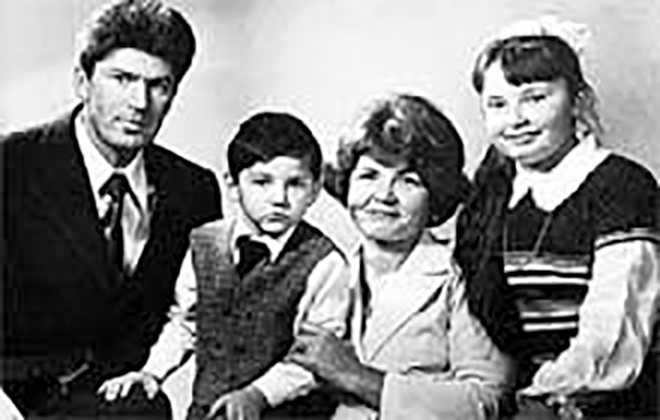

Valery Ryumin’s initial family
Ryumin’s marriage proposal came after just two days of knowing each other and was a complete surprise to Kondakova. She agreed to become Valery Ryumin’s wife a year later. In the mid-1980s, they welcomed their daughter Eugenia.
Valery Ryumin strongly opposed the idea of sending female pilots into space. Therefore, his wife’s desire to fly into orbit was met with strong resistance. In the politically correct United States, feminists were outraged when they heard Ryumin’s speech at a conference, where he openly expressed his negative views on women in space.
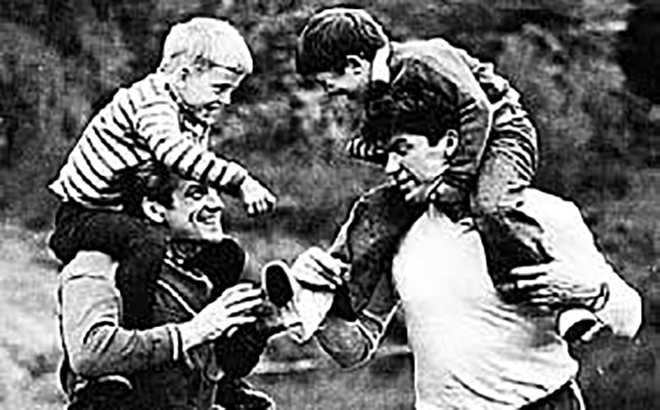
Vladimir Kovalenok and Valery Ryumin with their children
However, the wife successfully managed to overcome the opposition: Kondakova made two trips to space and achieved the title of Hero of the Soviet Union. The medical examination was passed by the woman when her daughter Zhenya turned 3 years old. After 5 years, Elena went into orbit, spending a total of six months on her first flight. Her husband Valery Ryumin and their 8-year-old daughter Zhenya eagerly awaited her return at home.
Upon arriving at the designated landing site in Kazakhstan, Valery Ryumin’s anticipation grew as he awaited the arrival of his wife. In his hands, he held a vibrant bouquet of roses, ready to greet her with a heartfelt gesture. Memories flooded his mind of the tragic fate that befell the crew of three Soviet pilots in these very Kazakh steppes, causing a sense of unease to wash over him. As he anxiously waited, thoughts lingered on how his own wife, once a part of the space industry, had chosen a path divergent from that of their children, who pursued professions far removed from the reaches of outer space.
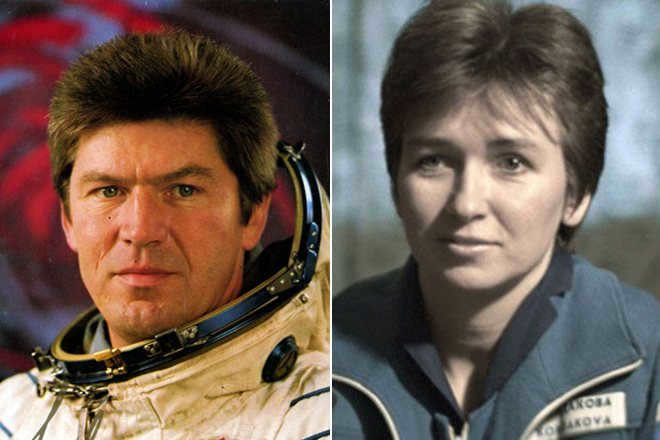
Valery Ryumin and his spouse, Elena Kondakova, enjoy spending their leisure time engaging in activities such as fishing and exploring the forest in search of mushrooms and berries. Valery Ryumin also keeps up with the accomplishments of Russian soccer and hockey players, and he finds enjoyment in reading historical books and memoirs written by famous individuals.
In honor of Valery Ryumin’s birthday, his crew members Sergei Nikitin and Yuri Vizbor composed a collection of songs titled “Ryuminiada,” which they presented to him during a teleconference in August 1980.
After completing his fourth flight and retiring as a ship pilot, Valery Ryumin transitioned to a ground-based role in the fall of 1998. He now holds senior positions at the Energia Corporation in Korolev and oversees the ISS program.
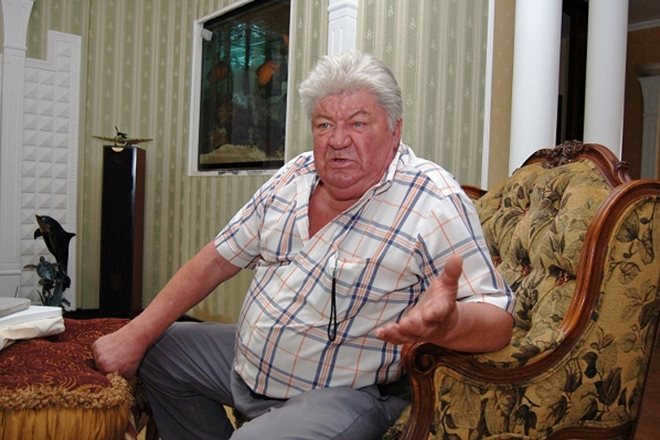
Valery Ryumin was captured in a photograph in 2017.
Valery Ryumin is the author of the books “A Year Off Earth” and co-writer of RSC Energia, which is named after S. P. Korolev.
Post-spaceflight
Starting in 1982, pilot-cosmonaut Ryumin took on the role of head of the flights for the “Salyut” and “Mir” stations, as well as the new spaceship “Buran”. Although this work did not involve actual space travel, it was still fascinating as it dealt with spacecraft and involved new ideas and developments. The stations were constantly evolving with the addition of new and improved equipment, which underwent testing and refinement.
In the autumn of 1986, Valery Ryumin decided to retire, which led to his expulsion from the squadron. Subsequently, he was appointed as the deputy designer at NPO Energia. In 1994, this exceptional specialist was chosen to lead the international space program on behalf of Russia. Valery Vasilyevich held this position until 1998. During the summer of ’97, he was selected to participate in the final shuttle flight to our space station “Mir”. The international crew’s mission included delivering cargo, conducting scientific activities, and returning with cargo. Following seven months of training with the international team, cosmonaut V. Ryumin once again embarked on a journey into space on June 2, 1998. As part of the crew, this flight specialist, who held the rank of lieutenant colonel in the reserve, diligently carried out his assigned duties for almost ten days. On June 12th, he safely returned home to Earth. After his fourth flight, Valery continued his work and since ’98 he has been serving as the ISS program director and the head of STC for testing and mission control, showcasing his expertise in these highly demanding roles.
He authored the book “A Year Off Earth” and also wrote scientific articles.
Awards
Ryumin, Valery Viktorovich
Valery Ryumin was born on August 16, 1939 in Komsomolsk-on-Amur, Russia, in a family of a civil servant.
After completing his high school education, he enrolled at the Kaliningrad Mechanical College in the Moscow region, specializing in cold metal working. Upon graduation in 1958, he furthered his education by attending the Faculty of Electronics and Calculating and Resolving Technology at the Moscow Forestry Institute, where he obtained his diploma in 1966. Subsequently, he joined the OKB-1 (Korolev Design Bureau) and contributed to the development of electrical testing documentation for the manned spacecraft “7K-L1” for lunar orbit. Throughout his career, he held various technical positions, including test manager and technical supervisor. In 1972, he became a member of the CPSU.
He became a member of the Soviet Cosmonauts Squadron in 1973, where he successfully completed an extensive training program focused on general space skills, as well as specific preparation for missions on Soyuz spacecraft and Salyut orbital stations.
As a flight engineer, he had the opportunity to participate in three space flights.
The first one took place from October 9-11, 1977, alongside spacecraft commander Vladimir Kovalyonok on the Soyuz-25 spacecraft. The mission objectives included docking with the Salyut-6 OS and conducting experiments on board. However, due to a malfunction with the spacecraft, the docking had to be cancelled and the flight was cut short.
On August 19, 1979, the title of Hero of the Soviet Union with the Order of Lenin and the medal “Gold Star” (№ 11429) was awarded to pilot-cosmonaut Valery Viktorovich Ryumin by the Decree of the Presidium of the Supreme Soviet of the USSR. This honor was given to Ryumin in recognition of his courage and heroism displayed during his flight.
A postage stamp issued by the USSR features Leonid Popov and Valery Ryumin.
From April 9 to October 11, 1980, Valery Ryumin accomplished the third mission on the Soyuz-35 spacecraft, commanded by Leonid Popov, and the Salyut-6 orbital research complex. This flight set another record for duration, lasting 185 days. During this time, the main crew conducted various studies, experiments, and repair operations, receiving four visiting expeditions, including three international ones. At the end of the mission, cosmonauts Popov and Ryumin returned to Earth aboard the Soyuz-37 spacecraft.
On October 11, 1980, Valery Viktorovich Ryumin was awarded the second “Gold Star” medal by the Decree of the Presidium of the Supreme Soviet of the USSR in recognition of the successful completion of this mission.
After retiring from the Cosmonaut Squadron on October 28, 1987, the brave space explorer took on a role in the Mission Control Center.
In July 1997, following a decision by the State Interdepartmental Commission (SIC) in collaboration with NASA, Valery Ryumin, a retired Soviet cosmonaut, was chosen to participate in the STS-91 program and fly on the shuttle. From September 5, 1997 to June 1998, Ryumin underwent training at the Johnson Space Center in the United States as part of the Discovery shuttle crew, serving as a mission specialist.
On his fourth spaceflight, which lasted 9 days, 19 hours, 55 minutes, and 1 second, V.V. Ryumin served as a flight specialist on the Discovery STS-91 shuttle from June 2 to June 12, 1998. The mission included the 9th and final docking with the Mir orbital complex.
Upon completing his fourth flight, reserve lieutenant colonel V. V. Ryumin once again became a retired cosmonaut. At the age of 58, V. Ryumin also holds the title of being the oldest cosmonaut in Russia to have been in orbit. Prior to his achievement, this record was held for 13 years by Georgy Grechko until it was surpassed by Pavel Vinogradov in 2013.
V. V. Ryumin’s wife is Elena Vladimirovna Kondakova, a pilot-cosmonaut of the Russian Federation and a Hero of the Russian Federation.

